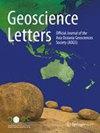利用累积绝对误差确定震级,用于地震预警
IF 4.3
3区 地球科学
Q1 GEOSCIENCES, MULTIDISCIPLINARY
引用次数: 0
摘要
P 波到达后 3 秒窗口的累积绝对衰减(CAA)可用于估算地震的震级(${M}_{CAA}$$)。即使只使用离震中最近的 6 个台站,这种方法也能取得很好的结果。无论使用 6 个还是 20 个台站,估计的 CAA 震级(${M}_{CAA}$$)与矩震级(${M}_{w}$$)之间的标准偏差均为 0.3。这说明,使用最近的 6 个站点可以可靠地预测 ${M}_{CAA}$$。另一方面,使用最近的 20 个站点根据 ${P}_{d}$ 得出的幅度(${M}_{Pd}$)与估计的 ${M}_{Pd}$ 和 ${M}_{w}$ 之间的标准偏差为 0.4。这表明 CAA 是比${P}_{d}$$更好的确定 EEW 系统幅度的参数。本文章由计算机程序翻译,如有差异,请以英文原文为准。
Magnitude determination using cumulative absolute absement for earthquake early warning
The cumulative absolute absement (CAA) of the 3 s window after P-wave arrival can be used to estimate the magnitude ( $${M}_{CAA}$$ ) of an earthquake. This method can achieve good results even when only the six stations nearest to the epicenter are used. The standard deviation between the estimated CAA magnitude ( $${M}_{CAA}$$ ) and the moment magnitude ( $${M}_{w}$$ ) is found to be 0.3 when using either 6 or 20 stations. This means that $${M}_{CAA}$$ can be reliably predicted using the closest 6 stations. On the other hand, the magnitude ( $${M}_{Pd}$$ ) derived from $${P}_{d}$$ using the closest 20 stations has a standard deviation of 0.4 between the estimated $${M}_{Pd}$$ and $${M}_{w}$$ . This suggests that CAA is a better magnitude determination parameter for the EEW system than $${P}_{d}$$ .
求助全文
通过发布文献求助,成功后即可免费获取论文全文。
去求助
来源期刊

Geoscience Letters
Earth and Planetary Sciences-General Earth and Planetary Sciences
CiteScore
4.90
自引率
2.50%
发文量
42
审稿时长
25 weeks
期刊介绍:
Geoscience Letters is the official journal of the Asia Oceania Geosciences Society, and a fully open access journal published under the SpringerOpen brand. The journal publishes original, innovative and timely research letter articles and concise reviews on studies of the Earth and its environment, the planetary and space sciences. Contributions reflect the eight scientific sections of the AOGS: Atmospheric Sciences, Biogeosciences, Hydrological Sciences, Interdisciplinary Geosciences, Ocean Sciences, Planetary Sciences, Solar and Terrestrial Sciences, and Solid Earth Sciences. Geoscience Letters focuses on cutting-edge fundamental and applied research in the broad field of the geosciences, including the applications of geoscience research to societal problems. This journal is Open Access, providing rapid electronic publication of high-quality, peer-reviewed scientific contributions.
 求助内容:
求助内容: 应助结果提醒方式:
应助结果提醒方式:


